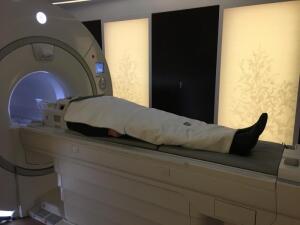by
Lisa Chamoff, Contributing Reporter | December 01, 2017

Image courtesy of GE Healthcare
CHICAGO – GE Healthcare has unveiled an innovative new set of coils for its SIGNA Premier wide bore 3T MR system, with a flexible design meant to increase patient comfort during whole body exams.
Using what GE calls adaptive imaging receive (AIR) technology, the coils debuting at the 2017 RSNA annual meeting have the look and feel of an electric blanket. They are 60 percent lighter and more flexible than previous bulky, heavy and rigid RF coils, and fit a wide variety of patients, according to the company, which this week announced U.S. FDA 510(k) clearance for the product. The lightweight design makes it easier for the technologist to position the patient.
The flexible material also gives the coils a higher-density channel count, providing increased signal-to-noise ratio and better image quality, according to the company.



Ad Statistics
Times Displayed: 47052
Times Visited: 1430 MIT labs, experts in Multi-Vendor component level repair of: MRI Coils, RF amplifiers, Gradient Amplifiers Contrast Media Injectors. System repairs, sub-assembly repairs, component level repairs, refurbish/calibrate. info@mitlabsusa.com/+1 (305) 470-8013
At the GE Healthcare booth at RSNA, there was a glass display case housing both the older, more rigid copper design and the AIR technology. In between the two was a small AIR coil folded up and placed in a cup, showing off its flexibility.
“There’s a limit to how you can bend it before the copper surface will crack and break,” Michael Brandt, chief marketing officer for MR at GE Healthcare, told HCB News. “In the cup is actually an AIR coil. It’s so flexible you can roll it up and put it into a cup.”
Fraser Robb, part of the design team for the AIR coils, said the engineers actually delivered the new coils to GE’s management in a coffee cup.
Robb noted that there have only been incremental improvements since GE invented the phased array coil back in 1990.
“You want that coil as close to the body as you can to capture all the electromagnetic signals that are coming from the body,” Robb said.
The AIR coils can also be used on patients that have difficulty breathing, or on fragile newborns that can’t take any weight in their chest. Robb said staff at the Lucile Packard Children's Hospital at Stanford used it on an infant with success.
“They just wrapped the baby up and the baby was happy, the doctors were happy,” Robb said. “It worked really well.”
The AIR technology is available in a 48-channel head coil, a 30-channel anterior array providing 65 centimeters of coverage, and a 60-channel posterior array providing 110 centimeters of coverage.

